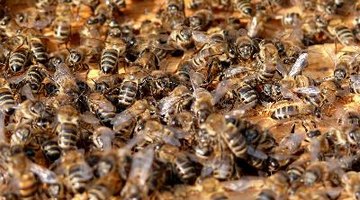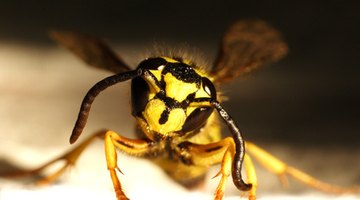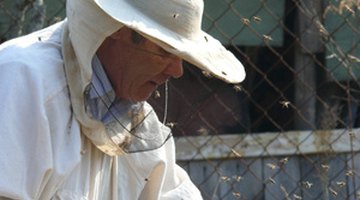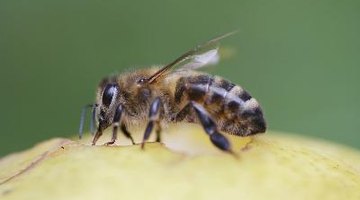Bees & Light Fixtures
Bees sometimes seek hollow cavities in a building as a sheltered location to raise their brood and store food. Any open cavity is a welcome mat to swarming bees: holes in exterior siding, roof eaves, gaps above room additions or between chimneys and walls.

Light fixtures with bees indicate that the bees are nesting in a wall or ceiling cavity and are using the fixture as an entrance and exit.
Identification

Identification of the type of insect is the crucial first step in removing them from the light fixture. People commonly mistake all flying stinging insects as "bees," but this is not accurate. Honeybees are hairy, amber-colored insects with thick legs meant for storing flower pollen. Yellow jackets have no hair, and their bodies are bright yellow with black stripes. Carpenter bees and bumble bees appear very similar with thick, hairy bodies and black legs. Carpenter bees are smaller and sport a solid black abdomen, whereas bumblebees have a thick yellow stripe. The appearance of the hive also reveals the identification of the insect. Honeybees produce light yellow honeycombed hives of wax. Yellow-jackets craft gray-colored paper nests in a hexagonal, honeycomb pattern. Carpenter bees nest in old wood; bumblebees prefer underground nests.
The Light Appeal

Oftentimes, a colony of bees has built a nest inside a wall or an attic. Bees and wasps are naturally attracted to light and heat, and the unsealed holes for attic electrical conduits and wall- or ceiling-mounted light fixtures provide a convenient ingress and egress for the bees. If trapped inside the light fixture, the bees or wasps will dry out and die. To prevent bees from entering small gaps, cracks and holes in and around light fixtures, homeowners should use exterior silicone or acrylic caulk or screening to seal off open areas.
Removal

Removal is best undertaken by a professional pest remover or beekeeper, especially if the pests are yellow jackets or other severely stinging pests. Professionals can access more potent and fast-acting chemicals, such as pyrethrins or insecticidal dusts. Home remedies such as boric acid or diatomaceous earth dehydrate bees, but may take several applications over a few days. A cotton ball soaked in acetone and placed near the hive will kill bees, but flammable solvents should not be applied in areas of electricity.
Environmental Concerns

The U.S. Department of Agriculture reports that honeybee colonies are in sharp decline in a phenomenon called "Colony Collapse Disorder." Total managed bee colonies in the United States have fallen from 5 million colonies in the 1940s to only 2.4 million in 2010. If possible, removal of honeybees from light fixtures and other areas should be accomplished as humanely as possible. Beekeepers may remove bees for free, or homeowners can purchase a bee "smoker." A smoker is a humane device that emits vapors that make bees sleepy and passive. Bees will seek a way out and away from the smoke; once emptied, the light fixture can be cleaned and the gap in the wall or ceiling sealed.
References
Writer Bio
Rebecca Mecomber, a former radio broadcaster, has been a professional blogger and writer since 2006. Her articles and interviews have appeared in "The Wall Street Journal," Salon.com and several other publications, covering topics such as Federal Trade Commission policy and media regulations, blogging, home improvement and New York travel.
Photo Credits
- bee bees apises beehive hive insect image by Pali A from Fotolia.com
- bee bees apises beehive hive insect image by Pali A from Fotolia.com
- hornet image by Dwight Davis from Fotolia.com
- å¤–ç¯ image by Reika from Fotolia.com
- hiver apiaristk beekeeper beeyard image by Pali A from Fotolia.com
- honeybee image by siloto from Fotolia.com
More Articles



